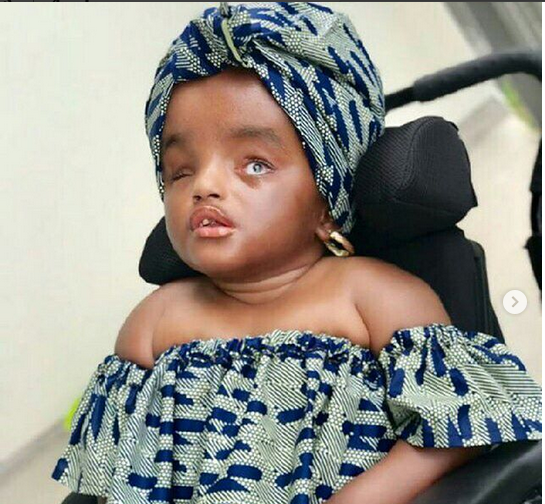“Doctors told us she would die at 3 months.” Mum of 4-Year-Old Amanda Creates Awareness About Hydranencephaly

Amanda’s mother was told that her baby has Hydranencephaly, a condition in which the brain’s cerebral hemispheres are absent to varying degrees and the remaining cranial cavity is filled with cerebrospinal fluid, after she went for scan seven months into her pregnancy.
She finally welcomed her baby and due to Amanda’s condition, she had a brain surgery when she was 8 months old. After the successful surgery, doctors told Amanda’s mom her baby would not survive 3 months.
Interestingly, Amanda defied doctors’ reports as she marked her 4th birthday on the 4th of this month. Full of excitement, Amanda’s mother has shared her testimony to create awareness about hydrocephalus to help other moms who have special kids like hers.
She shared photos of her baby girl and wrote;
”I found out about Amanda’s condition after doing a scan seven months into the pregnancy. Amanda is a hydranencephaly survivor (a central nervous disorder characterized by a large head and neurological deficits). She had a brain surgery when she was 8 months old.
READ ALSO: Photos: Baby Doctors Advised Should Be Aborted Defies Odds To Celebrate First Birthday
The doctors told us Amanda would die at 3 months but she is here and she will be 4 years on the 4th of July. Amanda can not see, talk, sit by her self, nor do anything but she can hear and differentiate between light and darkness. She can also smile.
Her condition has affected me emotionally, physically and mentally, in ways that I’m now spiritually strong and physically weak.
She cried continuously in my ears for more than two years, I have become accustomed to the sound of Amanda crying, to the extent that if I am seated somewhere quite, it feels like my head wants to explode. It was disturbing and I could hardly get any sleep.
Nonetheless, I am proud of my little girl because she has been strong right from the first day; through the surgeries and the pains, she has endured it all.
READ ALSO: Tanzanian Model Battling Endometriosis Defiles All Odds as She Welcomes Baby Boy
Creating awareness about hydrocephalus isn’t easy because mothers with affected children usually hide their children. I believe exposing pictures of her life journey on the Instagram and Facebook platform has helped so many mothers out there.”
According to Healthline.com,
Hydranencephaly is a rare birth defect that drastically affects brain development. Babies born with this neurological condition are missing the right and left hemispheres of the cerebrum.
The cerebrum normally forms the front of the brain. In place of the missing hemispheres, cerebrospinal fluid, or the fluid that cushions the brain and spinal cord, fills the cranial cavity.
Hydranencephaly is incurable. It’s not uncommon for babies with this condition to die in utero or within a few months after birth.
Babies born with hydranencephaly may have obvious symptoms at birth. In some cases, it may take weeks or months for obvious signs to appear. One of the most noticeable symptoms of hydranencephaly is an enlarged head size. Infants with the disease may have increased muscle tone, but limited movement.
Other common hydranencephaly symptoms include:
- seizures and uncontrolled movements
- lack of growth
- breathing and digestion problems
- difficulty regulating body temperature
- vision problems
- intellectual disability
Hydranencephaly is the result of injury to a baby’s nervous system or an abnormal formation of it. It occurs during the earliest stages of development in the uterus. But it’s not entirely clear what causes these problems.
Hydranencephaly may be an inherited condition. One theory about the abnormal brain development is that there’s blockage in the carotid artery. That’s the blood vessel that carries blood to the brain. However, researchers don’t have an explanation for why the carotid artery would become blocked.
Other possible causes include:
- an infection of the uterus early in the pregnancy
- a mother’s exposure to environmental toxins
- other circulation problems with the baby
Diagnosing hydranencephaly isn’t always done at birth. Sometimes it may take a few months before symptoms become noticeable.
One common diagnostic test is transillumination. This is a painless procedure. During the procedure, your baby’s doctor will shine a bright light at the base of their head to see if there’s fluid under the skin. This test can often reveal whether there’s abnormal brain formation.
Your baby’s doctor may also use a special X-ray to take images of your baby’s blood vessels using a dye. This is called an angiogram. It helps reveal abnormalities with circulation.
Another imaging test your baby’s doctor may use is called a CT scan. This test can provide the doctor a detailed and layered look at the brain.
Hydranencephaly affects the mental and physical health of a child. There are several conditions that tend to go hand in hand with hydranencephaly. Among them are:
- Asthma or reactive airway disease (RAD): Asthma can’t usually be diagnosed until a child is older, so the more general diagnosis of RAD is made when there’s an obvious respiratory problem. The specific cause is unknown.
- Cerebral palsy: A group of disorders affecting muscle movement and coordination. Vision, hearing, and sensation are also often affected.
- Constipation: This is sometimes made worse by a limited diet and medications to control seizures.
- Diabetes insipidus: A condition in which the kidneys can’t conserve water. Your child will have excessive urine output and higher sodium levels in their bloodstream.
- Failure to thrive: Feeding a child with hydranencephaly is challenging. This then affects overall health, growth, and survival.
- Irritability: This may be related to muscle spasms and gastrointestinal distress.
Because hydranencephaly currently has no cure, treatment focuses on managing symptoms.




God bless Amanda. Her mother is a strong woman.